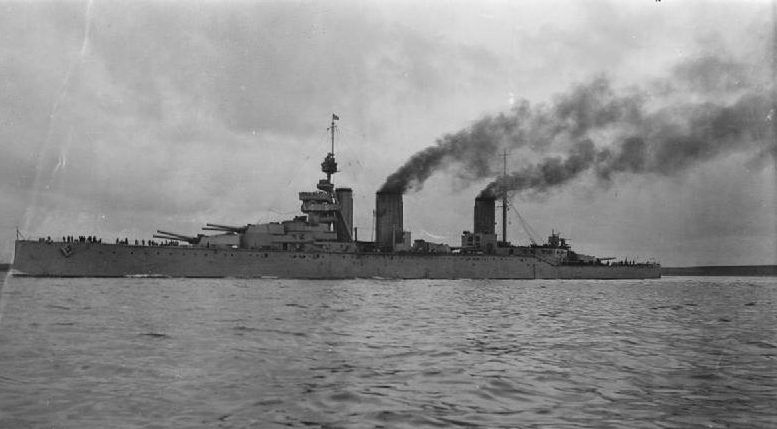Every now and again, a random question leads me to odd results … in this case I wondered about the Royal Navy ships named HMS Lion, which I remembered as being used for a First World War battlecruiser (Vice-Admiral Beatty’s flagship through the actions at Heligoland Bight and Jutland) and a Cold War light cruiser (whose sister ships were converted into hybrid light cruiser/amphibious assault ships). Earlier ships of that name had even more interesting careers (from the Wikipedia disambiguation page):

HMS Lion, lead ship of the Lion-class of Royal Navy battlecruisers.
Photo from the Imperial War Museum, via Wikimedia Commons.
- English ship Lion (1511) was a 36-gun ship of the Royal Scottish Navy captured in 1511 and sold in 1513.
- English ship Lion (1536) was a 50-gun ship built in 1536 and on the navy list until 1559.
- English ship Lion (1547) was a Scottish ship captured in 1547 and later lost off Harwich.
- English ship Lion (1557) was a 40-gun ship, also known as Golden Lion. She was rebuilt four times, in 1582, 1609, 1640 and 1658. After her 1609 rebuild she was renamed Red Lion, but this was reverted to Lion after the 1640 rebuild. She was sold in 1698.
Modern naval ships are considered long-in-the-tooth after 25-30 years of service. HMS Lion (the HMS was not consistently applied to royal ships until the eighteenth century, but let’s just let that slide here) of 1557 was only undergoing her first rebuild/life extension at the point a modern ship would already be under consideration for dismantling. She was still in royal service for three more rebuildings, and was sold (not scrapped) after 141 years of active service. But the Royal Navy was far from done with using this name:
- HMS Lion (1665) was a 6-gun ketch, also known as Young Lion. She was captured from the Dutch in 1665, sold in 1667, repurchased in 1668 and sunk as a foundation at Sheerness in 1673.
- HMS Lion (1683) was a fifth rate captured from the Algerians in 1683 and sold the same year.
- HMS Lion (1702) was a 4-gun stores hoy of 99 tons burthen purchased in 1702. A French privateer captured her off Beachy Head in 1708, but she was recaptured in 1709.[1]
- HMS Lion (1709 hoy) was a 4-gun hoy launched in 1709. She was wrecked in 1752.[2]
- HMS Lion (1709) was a 60-gun third rate launched in 1709, rebuilt in 1738 and sold in 1765.
Another longer-service veteran than the vast majority of modern naval ships.
- HMS Lion (1753) was a transport launched in 1753, hulked in 1775, and sold in 1786.
- HMS Lion (1763) was a cutter purchased in 1763 and sold in 1771.
- HMS Lion (1774) was a discovery vessel in service from 1774 to 1785.
- HMS Lion (1777) was a 64-gun third rate launched in 1777. She was used as a sheer hulk from 1816 and was sold for breaking up in 1837.
One assumes the name was changed before 1781, even though the hull was still in use for long after other ships named HMS Lion were respectively in commission and then out of service with the Royal Navy:
- HMS Lion (1781) was a schooner purchased around 1781 and sold in 1785.
- HMS Lion (1794) was a 4-gun vessel, originally a Dutch hoy. She was purchased in 1794 and sold in 1795.
- HMS Lion (1823) was a schooner in service from 1823 and sold in 1826.
- HMS Lion (1847) was an 80-gun second rate launched in 1847. She was converted to screw propulsion in 1859 and became a training ship after 1871. She was sold for breaking up in 1905.
- HMS Lion (1910) was a Lion-class battlecruiser launched in 1910 and sold in 1924.
- HMS Lion (1939) was to have been a Lion-class battleship. She was laid down in 1939, but work was suspended later that year, and again in 1942. The order was finally cancelled in 1945 and she was broken up on the slipway.
- HMS Lion (C34) was a Tiger-class cruiser launched in 1944 as the Minotaur-class HMS Defence. She was finally completed to a revised design in 1960. She was placed in reserve in 1964 and was scrapped in 1975.



